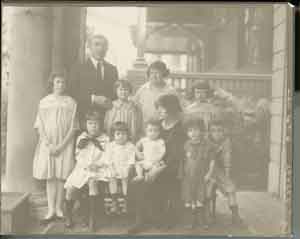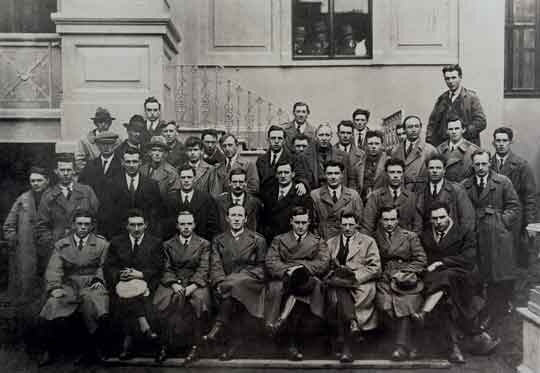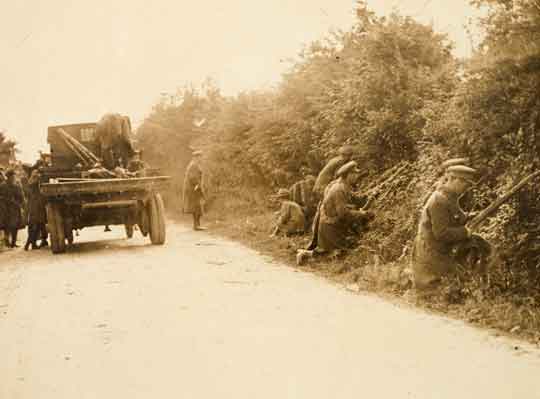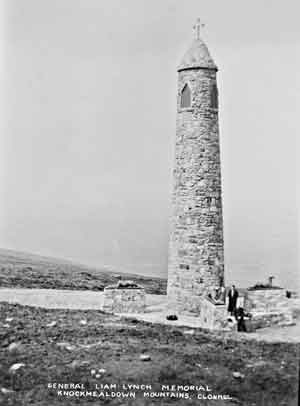‘I AM CONFIDENT THAT IF WE STAND UNITED VICTORY IS CERTAIN’—LIAM LYNCH’S STRATEGIES IN THE FINAL MONTHS OF THE CIVIL WAR
Published in Features, Issue 2 (March/April 2023), Volume 31By Gerard Shannon

Above: Clan na Gael leader Joseph McGarrity and his family in 1919. Writing to Lynch from America in mid-January 1923, McGarrity felt that the ‘scales could turn in our favour’ if artillery could be purchased. (UCD-OFM Partnership)
As 1922 ended, Liam Lynch—chief of staff of the anti-Treaty IRA—admitted in a private communication that he did not anticipate the republican military resistance to succeed against the forces of the Irish Free State. He was responding to a warning by Eamon de Valera, who felt that the IRA should not expect a conventional military victory. De Valera was by now a marginal figure of little influence on the six-month-old conflict, and headed an irrelevant underground ‘republican government’ subordinate to the IRA Executive headed by Lynch. Naturally, tensions arose with increasingly frequency between the two men.
Lynch admitted: ‘We cannot hope to completely overthrow the enemy unless the unforeseen happens … What I hope for, and am definite will secure, is to bring the enemy to the position of bankruptcy …’. Once that occurred, Lynch imagined that the Free State government would ‘stand with us in upholding our independence’ against the common enemy of Britain. At least one senior officer felt this strategy to be unrealistic, given that the new Free State government had a seemingly endless supply of finance and resources from the British.
PRIVATE AGONIES
Lynch had wrestled with private agonies throughout the previous months. In September he admitted in a letter to one brother that the ‘disaster of this war is sinking to my very bones … Who could have dreamt that all our hopes could have been so blighted.’ Similarly, he wrote to his mother in December that he had ‘not much hope of an early ending as our present enemy still insists on dishonouring the nation by forcing her into the British empire’.
Such private remarks are a far cry from the optimism that Lynch often exuded in his public dispatches. Nonetheless, he continually gave good advice to senior IRA commanders and could be intensely critical. In a particularly searing communication to all O/Cs at the end of January 1923, he complained of the lack of information from divisions on both the strength of the enemy and their own side. Thus the republican resistance after six months was ‘in the ridiculous position of not knowing how we stand in this area’. In tandem, Lynch continued to pepper his communications with words of encouragement and the promise of republican success. For instance, while assuring Joe O’Connor, the quartermaster of the First Southern Division, at the end of January that ‘it is only a matter of time until we come out on top’, Lynch admitted that GHQ ‘have realised that enemy has steam-rolled the area’, leading to a lack of IRA actions.
As the new year dawned, the forces of Lynch’s IRA faced enormous obstacles: the imprisonment of hundreds of IRA volunteers; the continued State executions; and the guerrilla phase of the conflict descending into small IRA operations, with only localised success. Lynch also faced increasing pressure from various quarters to take part in an array of different peace initiatives.

Above: Liam Lynch (front row, fourth from left) with the leadership of the First Southern Division at the IRA Army Convention in March 1922. (Kilmainham Gaol Museum)
One particular blow that February was the capture of Lynch’s deputy Liam Deasy, the commander of the IRA’s First Southern Division. From captivity Deasy issued a communication to Lynch and other leaders and implored them to end the conflict, his plea carrying particular weight given his stature as a senior republican figure. In addition, Lynch and the republican military leadership were faced with increasing pressure to hold a meeting of the IRA’s Executive, which was eventually set to be held at the base of the Knockmealdown Mountains in late March.
Following Deasy’s capture, Lynch departed his GHQ base in north Dublin to venture to his old command area of the First Southern Division. He felt that he could get a better sense on the ground in an area he knew so well, while at the same time he was more determined than ever for his forces to find some advantage.
ARTILLERY
At the outset of the year, Lynch sought to secure heavy artillery for the IRA. Central to these schemes was the Irish-American benefactor Joseph McGarrity of the most prominent republican organisation in the United States, Clan na Gael. Writing to Lynch in mid-January, McGarrity felt that the ‘scales could turn in our favour’ if the artillery purchases got moving in a month or two.
Lynch shared this view and told de Valera that the use of such artillery could turn the tide of the war within a week: ‘… it would be easy to make terms with the enemy’. De Valera worried ‘that a piece of artillery will hamper the mobility of our columns and will be difficult to keep concealed and to retain under the conditions of this war’. Nonetheless, he expressed some hope that the much-anticipated artillery might yet affect the balance of forces, advising Lynch that if ‘we had two or three of these mountain guns in each Division, with proper concentration of our forces, we would smash up all the enemy posts’.
On the type of weaponry he desired, Lynch felt that ‘… small guns would do us … if big one with gunners and other experts can be landed, so much the better. We can then make a clean sweep.’ On 16 March, from the United States, Seán Moylan, as a representative of the republican government there, assured Lynch that he had ‘done everything but shoot people in order to impress its urgency on the men here’.
Correspondence from this period shows Lynch even attempting to plan the transport of this material whenever it was received. In one communication, he speculated: ‘If these supplies cannot come by submarine, a cargo landing is impossible on the south or south-west coast therefore, you must perfect elsewhere’. He went as far as to consider a pilot landing of such material in the area of the Western Division.
OPTIMISTIC REPORTS FROM THE WESTERN DIVISION
Just prior to the March Executive meeting Lynch’s adjutant, Maurice ‘Moss’ Twomey, composed a lengthy memorandum to Lynch, listing the difficulties facing the IRA in various areas. Twomey admitted to Lynch: ‘News is not encouraging these days. There has not been a decent operation, whatever the cause is.’ With such initiatives proving difficult, it was important for Lynch to maintain the fighting in those areas in which he felt the anti-Treaty IRA had most success, such as the area overseen by the Western Division, then under Seán Hyde. Liam Deasy felt that Hyde’s ‘enthusiastic reports … did much to encourage and strengthen Lynch in his determination to carry on the fight’.

Above: National Army troops deployed in Munster in July 1922. At the end of January 1923, Lynch complained of the lack of information from IRA divisions on the strength both of the enemy and of their own side. (NLI)
An examination of reports sent by Hyde to Lynch in this period do indeed bear this out. Some weeks after Deasy’s public plea for surrender, Hyde assured Lynch that ‘Deasy’s action had no effect whatever in this area … the situation generally in this area is satisfactory. Developments are slow but in the right direction.’ Towards the end of February, Hyde again assured Lynch: ‘Activities are becoming more widespread every day, many of them are not reported in the press’. The effect of Hyde’s reports seems to be confirmed by Twomey’s remark to Moylan on 2 March: ‘Things are going very well since last report especially in the West, where our activities have increased immensely’.
Nonetheless, by mid-March even Hyde admitted in one communication that mass arrests had had a devastating impact in the area under his command. Possibly inspired by this, Todd Andrews, then an adjutant to Lynch, recalled a request from his chief of staff for Andrews to take over the Western Division before Lynch’s departure for the March Executive meeting. Such a request seemed extraordinary to Andrews, given that he had never commanded anything above a company and his unfamiliarity with the area.
IRA EXECUTIVE MEETING
It was in a grim atmosphere that the much-delayed Executive meeting took place between 23 and 26 March. Such was the difficulty with National Army raiding parties in the area that the meeting had to move to different secret locations in rural Waterford and Tipperary. The meeting demonstrated well the strong differences of opinion within the IRA leadership. Apparently, before the meeting began there was a debate among some present as to whether de Valera, the head of the republican government, should participate. De Valera was eventually allowed to be present but without voting rights. It represented a further marginalisation of the moribund republican government since its formation the previous October.
Lynch’s firm view, notwithstanding the losses, was to continue military resistance ‘until their opponents were forced to negotiate’. The other two options, neither of which Lynch advocated, were to abandon the military fighting or to dump arms. The total strength of the IRA at this juncture was determined as 8,000, with 13,000 in prison. In contrast, it was estimated that the National Army had nearly 40,000 in its ranks.
Frank Aiken proposed a motion that de Valera should begin negotiations. It resulted in a tie, with Lynch not voting. Tom Barry then put forward the proposal that ‘further armed resistance and operations against F.S. Government will not further the cause of independence of the country’. The result was five for and six against, with Lynch among the latter. Likely those who voted with Lynch against Barry’s resolution shared his view that it was best to wait for the acquisition of artillery. Given that it was impossible to reconcile the divergent views of those on the Executive, it was decided to adjourn the meeting for three weeks.
Lynch maintained a firm belief that the Western Division could carry the fight. However limited had been their successes, however dim the prospects, for Lynch it was important that some strain of military resistance to the Free State continue. This represented the very limit of his thinking in the days leading up to his death. The day before he died, he wrote to one senior IRA leader that ‘I am confident if we stand united that victory is certain and that in a short time’. This was a typical statement, a combination of Lynch’s own optimism and his determination to encourage those under his command.
DEATH
On the morning of 10 April, Lynch was mortally wounded by a bullet from a National Army sniper whilst fleeing across an open field on the Knockmealdown Mountains. He had been pursued along with several members of the Executive, whom he ordered to leave him behind as he lay dying on the ground. Some weeks later, Frank Aiken—who was one of those ordered to leave—wrote to Lynch’s brother Tom that ‘we knew how terrible was the blow that had fallen on the Nation and Army on being deprived of his leadership’.
Following Lynch’s death, communications to Seán Moylan ceased. Moylan was now adrift in Hamburg, Germany, without updates on the military situation in Ireland. This throws into relief how important Lynch was in keeping the flailing, desperate strands of the republican resistance together during this last phase. In later May, Moylan lamented to one contemporary that he awaited ‘a definite reply from Ireland together with some news as to conditions … Lynch certainly believed in keeping in touch with his outposts.’ Perhaps indicative of a lack of interest amongst the surviving leadership on the IRA Executive, the first meeting after Lynch’s death noted that there ‘was no good news from the men who had been endeavouring to purchase cannon’. After Moylan finally heard of the suspension of military operations by Aiken in late April, there was no further attempt on his part to secure an arms deal.
The surviving IRA Executive met again on 20 April, with Frank Aiken elected the new chief of staff and, according to the minutes, ‘The President was unanimously requested to take charge of any negotiations which might follow’. The Executive’s direction in late April that de Valera now seek peace with the Free State cabinet by presenting their terms is remarkably similar to a scenario on which Lynch had speculated to de Valera two months before. At the time, Lynch wondered whether republicans ‘should know that if possible first if there is a way out by which peace can be attained. At least should give the enemy our minimum terms and receive his and have these latter finally reviewed …’. He made it clear that he was not instructing de Valera to begin such efforts, adding that it was not a ‘good moment’ for a such a discussion. Perhaps, had he lived, Lynch might have realised that such a moment had arrived by late April, when his proposed ground artillery and his hopes in the IRA’s Western Division came to nothing.
Nonetheless, several weeks of negotiations between intermediaries resulted in no peace agreement, and ultimately Aiken issued a ‘dump arms’ order to all IRA units on 24 May. The Irish Civil War—and, more specifically, the military resistance that Lynch had hoped would bring the new Free State to financial ruin and then to the negotiating table—was over.
Gerard Shannon is the author of Liam Lynch: to declare a republic (Irish Academic Press, 2023).
Further reading
S. Cronin, The McGarrity Papers: revelations of the Irish revolutionary movement in Ireland and America 1900–1940 (Tralee, 1972).
Eamon de Valera Papers P150 (UCD-OFM Partnership).
F. O’Donoghue, No other law: the story of Liam Lynch and the Irish Republican Army 1916–1923 (Dublin, 1954).

















